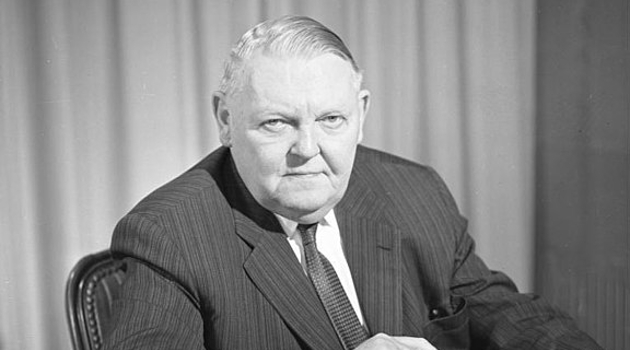A couple of years ago, to help build the case against socialism, I showed how West Germany enjoyed much faster growth and much more prosperity than East Germany.
The obvious lesson to be learned from this example of “anti-convergence” is that market-oriented economies out-perform state-controlled economies.
I want to revisit this topic because I recently dealt with someone who claimed that government spending via the Marshall Plan deserves the credit for West Germany’s post-war economic renaissance.
What does the evidence say? Was foreign aid from the United States after World War II a key driver (for Keynesian or socialist reasons) of the West German economy.
The answer is no.
Professor David Henderson explained the role of the Marshall Plan for Econlib.
After World War II the German economy lay in shambles. …less than ten years after the war people already were talking about the German economic miracle. What caused the so-called miracle? The two main factors were currency reform and the elimination of price controls, both of which happened over a period of weeks in 1948. A further factor was the reduction of marginal tax rates later in 1948 and in 1949. …Marshall Plan aid to West Germany was not that large. Cumulative aid from the Marshall Plan and other aid programs totaled only $2 billion through October 1954. Even in 1948 and 1949, when aid was at its peak, Marshall Plan aid was less than 5 percent of German national income. Other countries that received substantial Marshall Plan aid exhibited lower growth than Germany.
Moreover, the money that was dumped into Germany as part of the Marshall plan was offset by money that was taken out of the country.
…while West Germany was receiving aid, it was also making reparations and restitution payments well in excess of $1 billion. Finally, and most important, the Allies charged the Germans DM7.2 billion annually ($2.4 billion) for their costs of occupying Germany.
Inconvenient facts like this make the socialism or Keynesian argument very difficult to maintain.
In a 1990 study on whether there should be something similar to the Marshall Plan for Eastern Europe, Melanie Tammen summarized some of the research on how the original plan for Western Europe was a flop.
…those that received relatively large amounts of aid per capita, such as Greece and Austria, did not recover economically until U.S. assistance was winding down. Germany, France, and Italy, on the other hand, began their recovery before receiving Marshall Plan funds. As for Belgium, it embarked on a radical monetary reform program in October 1944, only one month after liberation. Belgium’s economic stabilization and recovery were well under way by 1946, fully two years before the arrival of U.S. aid. Great Britain, conversely, received more Marshall Plan aid than any other nation but had the lowest postwar economic growth rate of any European country. The critical problem facing Europe was…simply bad economic policy.
Kai Weiss of the Austrian Economic Center in Vienna also addressed this issue. Here’s some of what he wrote for the Foundation for Economic Education.
Common knowledge says that the United States’ Marshall Plan was responsible for the rapid economic growth, rebuilding the country by throwing a lot of money at it. But that’s a mistaken view. …why was there a “Wirtschaftswunder”? …two main reasons: a monetary reform and the freeing of the economy by abolishing price controls and cutting taxes. All of this was implemented thanks to one man: Ludwig Erhard. …What Erhard did was unthinkable in a hostile environment. The Allied forces, still heavily controlling Germany, left the Nazi price controls and rationing intact. But when Erhard became Secretary of the Economy in West Germany, he quickly ended all price controls and stopped rationing — to the dismay of the US advisors. …He, not a Keynesian Project like the Marshall Plan, enabled the miracle.
Speaking of Ludwig Erhard, here’s a video clip on what he did to trigger West Germany’s prosperity.
I have one minor disagreement with that video.
It states that Germany combined “free markets with a strong welfare state.”
That’s a very accurate description of, say, current policy in Denmark.
But total social welfare spending in Germany was less than 20 percent of GDP for the first few decades after World War II, considerably less than social welfare spending today in the United States.
At the risk of being pedantic, it would be more accurate to state that Germany combined free markets with a medium-sized welfare state.
Let’s close with one final bit of evidence.
Here’s a look at the most pro-market nations in the decades after the war. Germany (outlined in red) was never at the top of the list, but it was almost always in the top 10.

Was Germany a libertarian paradise?
Hardly.
But the main takeaway from today’s column is that it’s even more absurd to claim that Germany’s post-war growth was because of big government.
P.S. Regarding Eastern Europe, western nations ultimately decided to create a cronyist institution, the European Bank for Reconstruction and Development, in hopes of boosting post-Soviet economies. Needless to say, that was a mistake. Many nations have enjoyed good growth after escaping communist tyranny, but the cause was good policy rather than handouts.
P.P.S. The Erhard video is an excerpt from The Commanding Heights, a must-watch video that basically tells the economic history of the 20th century).
———
Image credit: German Federal Archives | CC BY-SA 3.0 DE.





